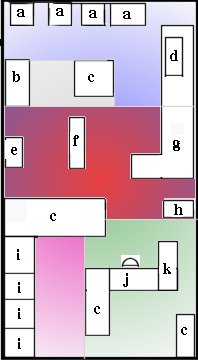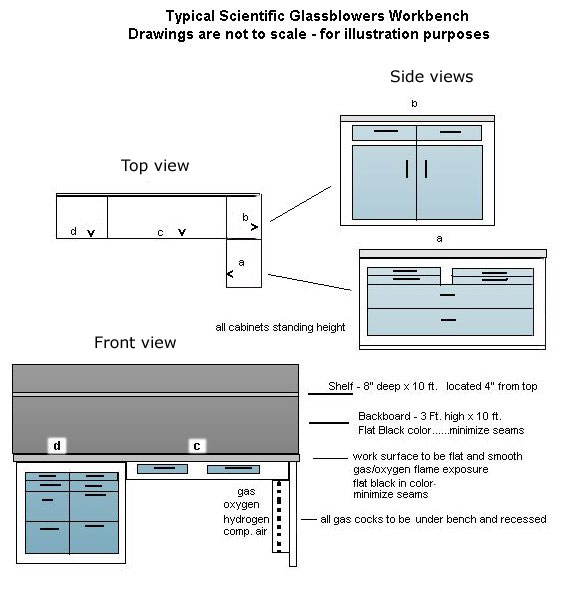 |
 Safety Emporium is a proud sponsor of this site. |
 |
Home Page --> Designing The Glassblowing Shop
|
 |
 Safety Emporium is a proud sponsor of this site. |
 |
Home Page --> Designing The Glassblowing Shop
|
Conversely, if your customer base covers a campus or large geographical area, then a location within your building that has higher visibility and easy access will be beneficial.
Other factors in selecting your shop location (if that's even a choice) will be the availability of facility services required by your operation, compatibility with surrounding laboratories and offices, HVAC logistics, and priority assignment within your organization.
Once the zone areas have been identified, you will need to document the services required for each zone. Electrical requirements, gases, communications, HVAC, and other facility-provided services need to be identified.
Once the number of zones and their functions have been identified, the layout of these zones will determine how efficient and functional your facility will be. Be sure adjacent zones complement each other.
Create an equipment data list that includes all services needed to run and use the equipment. This list should include at a minimum:
A successful floor plan allows safe and efficient use of space, movement and function within the space allocated to your facility. The typical planning process would layout the zones within room configuration and arrange equipment/ furniture within the each zone.
When at all possible, try to envision multi-use functions for every piece of furniture and space. Storage cabinets can function as barriers or dividers to keep customers away from potentially dangerous zones or to guide them to a consulting area. Work surfaces function as staging areas for incoming, in-process and outgoing glasswork. The dead space between banks of back to back cabinets offers additional storage space for those odd shaped items that do not fit easily in drawers or cupboards. Utilize vertical and horizontal space. Details are important at this stage. Locations of all services, furniture and equipment orientation should be specified.
Here is an example of the floor plans and zones developed for a new glassblowing shop in East Carolina University's Science and Technology Building. You can compare these plans to photographs of the completed facility to assist in your visualization:
| Zone Placement | Key | Floor Plan |
|---|---|---|
 |
Photo Tour of ECU's Glassblowing Facility
|
 |
Requirements: Desk, communication center (telephone, computer, data connections) storage, file drawer(s), book case, electric (110V), emergency gas shut-off valves.
Requirements: Hydrogen, propane or natural gas (at least 5 psi), oxygen, compressed air or nitrogen. Fuel gas and oxygen delivery lines to be at least 1/2 inch ID (preferably larger) with high flow regulators and valves. House vacuum if available. Electricity - 110V and 220V (208V future connection). An exhaust canopy (controlled by switch) over lathe and glassblowers bench [your HVAC experts will weigh in on this, too]. The glassblowers workbench should consist of standing height cabinet units with smooth, flat work surfaces and background, flat black in color.
Be sure to lay out the lathe, glassblowers bench and annealing oven to allow easy access to each and facilitate interaction between equipment.
Requirements: Hot and cold water, distilled or deionized water, drains, safety shower/eyewash station, compressed air, house vacuum. Specify separate storage cabinets for acids and flammable solvents. Consider secondary containment where necessary.
Other considerations are:
Requirements: Open rack style platform. Approximate floor space to be 10 feet in width x five foot depth x eight feet high. The unit should have shelves spaced 16 inches apart.
Other storage will be spread throughout the facility. Cabinet design and configuration to be placed for optimum multi-purpose use. All floor cabinets to be standing height with standard laboratory work surfaces except where noted on specification sheet.
110 V electric service should be sufficient in this zone.
Requirements: Propane or natural gas (at least 5 psi), oxygen, compressed air or nitrogen. Fuel gas and oxygen delivery lines should be at least 1/2 inch ID with high flow regulators and valves.
110 V electricity should suffice, an exhaust canopy (controlled by switch) over benches is ideal if your HVAC design permits it.
The workbenches should consist of standing height cabinet units with smooth, flat work surfaces and background, flat black in color.
For the main glassblower's station, this is a design that I came up with:

This page and any associated material is copyright 2002-2025 by Joe Walas and/or ILPI unless otherwise stated. Unauthorized duplication or posting on other web sites is expressly prohibited. Send suggestions and comments (include the URL if applicable) to us by email. CAUTION: Be sure to read this important safety/legal disclaimer regarding the information on this page.